|
Ferdinand
Magellan is acknowledged as being the first explorer to
go around the world although he did not complete the
journey. In
fact, the first person to sail around the world was a
Malaysian, who had travelled back to Europe with
Magellan many years earlier. Later, he accompanied
Magellan as an interpreter on the circumnavigation.
Ferdinand
(Fernao de Magalhaes) was a Portuguese sailor. He was
born in 1480 at Sabrosa and died in 1521. He discovered
the strait of Magellan.
Columbus
landed in the 'new world' of the Americas in 1492.
Explorers coming after him in the 16th century brought
the news to Europe that the Pacific Ocean lay beyond the
western coast of America. Suddenly people began to
understand that they could reach the East by sailing
westwards from Europe.
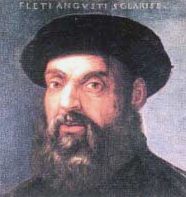
Europeans wanted silks, gems and spices from the East in
increasing quantities. At the end of the 15th century,
the Portuguese explorer Vasco da Gama had found a route
from Europe to India by sailing round the southern tip
of Africa, but people thought there might be another
route. Magellan
wanted to try to reach south-east Asia, where many
spices grew, by sailing westwards across the Atlantic
Ocean. As his own king wouldn't finance the voyage, he
got the help he needed from Spain instead. He hoped to
find a passage through South America so that he could
sail all the way from the Atlantic to the Pacific.
AKA
Fernão de Magalhães
Born:
1480
Birthplace: Sabrosa, Trás-dos-Montes, Portugal
Died: 27-Apr-1521
Location of death: Philippines
Cause of death: War
Gender:
Male
Ethnicity: White
Sexual orientation: Straight
Occupation: Explorer, Military
Nationality:
Portugal
Executive summary: Circumnavigated the globe
Magellan
was born of Portuguese nobility, though in his late
thirties he renounced his Portuguese citizenship and
came into service to the Spanish King Charles I.
It was to Charles that he announced his idea of
avoiding the well-entrenched Portuguese positions along
the route to the East Indies by sailing west from
Spain across the Atlantic and continuing in that
direction (by-passing the Americas) until he arrived at
the Indies from the East! He received Charles'
support and on September 20, 1519, he set sail from Sanlúcar
de Barrameda with five ships.
Magellan
convinced Charles V of Spain (1500-1558) to fund an
expedition to the southern part of the American
continent where he discovered Patagonia and Tierra del
Fuego. On November 28, 1520 Magellan crossed the strait
that was later named after him, venturing into a vast
ocean where no westerners had ever sailed before. For
the entire three months of north-westerly navigation,
the ocean remained calm, prompting the travelers to call
it the Pacific (the
name means that it is a calm, peaceful ocean). Magellan
sailed on to the Philippines.
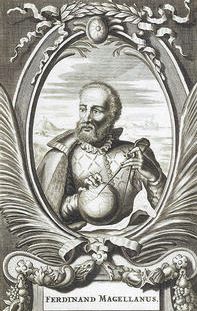
He
crossed the Atlantic and in November arrived at
modern-day Argentina, exploring the Río de la Plata and
coming ashore for the winter at Patagonia. Late
the next spring he then continued southward around the
storm-tossed and rocky straits off the southern tip of
South America (the "Straits of Magellan")
taking 38 days to make that dangerous passage, then
headed westward across the Pacific. He arrived at
the Marianas. He then continued on to the
Philippines, arriving there in March of 1521.
He
left Spain in 1519 with five ships and about 260 men. At
first he did not tell his men where they were going
because he thought they would be too frightened to obey
him.
Magellan found the strait that is now named after him,
but only by chance. When two of his ships were driven
towards land in a storm, the men feared they would be
dashed against the shore. Then, just in time, they
spotted a small opening in the coastline. Fortunately
for them, it was the passage for which they had been
searching since they left home.
The new ocean was extraordinarily calm and peaceful when
Magellan finally entered it, hence the PACIFIC OCEAN. By
now one of his ships had deserted, but the other four
started the journey across their newly discovered sea.
To everyone's amazement, the crossing was to take three
months and 20 days.
Nut it was not all plain sailing, for Magellan and his
men suffered terrible hunger. They ran out of fresh food
and many died of scurvy, an illness caused by a lack of
the vitamin C found in fresh fruit and vegetables. One
of the crew wrote:
'We
ate only old biscuit reduced to powder, and full of
grubs, and stinking from the dirt which the rats had
made on it when eating the good biscuit, and we drank
water that was yellow and stinking. The men were so
hungry that if any of them caught a rat, he could sell
it for a high price to someone who would eat it.'
Magellan
was born in Northern Portugal (either in Sabrosa or in
Oporto). His parents, Pedro Ruy de Magalhaes and Alda de
Mezquita, were members of the nobility (they were
wealthy and powerful).
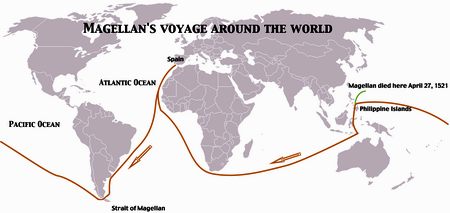
Early
in his career, Magellan sailed to India and to the Far
East many times via Africa's Cape of Good Hope. He
sailed for his native Portugal, but a dispute with the
Portuguese King Manoel II turned him against the
Portuguese. Thereafter, he sailed for Spain.
Magellan
and his friend the astronomer Ruy de Falero proposed to
King Charles V (of Spain) that a westward voyage around
the tip of South America would take them to the Moluccas
(spice-rich islands) and avoid the Portuguese (with whom
they were competing fiercely). The voyage began
September 8, 1519, and lasted until September 6, 1522
(almost 3 years). Magellan sailed from Seville, Spain,
with five ships, the Trinidad, San Antonio, Concepcion,
Victoria, and Santiago. Three years later, only one ship
(the Victoria) made it back to Seville, carrying only 18
of the original 270 crew members. Magellan was killed
towards the end of the voyage, on the Island of Mactan
in the Philippines, during a battle with the natives.
The Basque navigator Juan Sebastián de Elcano (del
Cano) completed the trip.
Portuguese
mariner, honoured with being the first circumnavigator
of the globe as a result of his leadership of the
Spanish-funded circumnavigation of 1519-22 which
comprised 5 ships & 270 men. It is slightly
inaccuarate honour to give to Magellan, as he was in
fact killed on the Philippine island of Mactan in April
1521 and the final part of the expedition from Asia to
Europe was completed under the leadership of Sebastiano
del Cano. Magellan's flagship Victoria arrived
back in Spain in September 1522 with only 18 remaining
survivors. Magellan discovered the Pacific Ocean, via a
route through the dangerous Straits at the southern tip
of South America, which now bear his name. Much of what
is known of Magellan's expedition comes from the account
of one of the few survivors, the Italian Antonio
Pigafetta.
Ferdinand
Magellan, in Spanish Fernando Magallanes, or Fernã de
Magalhães, the first circumnavigator of the globe, was
born at Sabrosa in the Villa Real district of the
Traz-os-Montes province of Portugal. He was a son of
Pedro de Magalhães, and belonged to the fourth order of
Portuguese nobility (fidalgos de cota de armas).
He was brought up as one of the pages of Queen Leonor,
consort of King João II. In 1495 he entered the service
of Manuel, João's successor, and in 1504 enlisted as a
volunteer for the Indian voyage of the first Portuguese
viceroy in the East, Francisco d'Almeida. He sailed on
the 25th of March 1505; was wounded at Cannanore on the
16th of March 1506; was then sent with Nuno Vaz Pereira
to Sofala to build a Portuguese fortress at that place;
returned to India early in 1508; and was again wounded
at the battle of Diu on the 3rd of February 1509. At
Cochin (August 19, 1509) he joined Diogo Lopes de
Sequeira on his famous voyage intended for the Spice
Islands, when the Portuguese almost fell victims to
Malay treachery at Malacca. In this crisis he fought
bravely and skilfully (though it is not true, as often
asserted, that he discovered the Malay plot); and before
the 10th of October 1510 he had been rewarded for his
many services with the rank of captain. He again
distinguished himself at the taking of Malacca by
Albuquerque (July-August 1511), and was then sent on by
the viceroy with Antonio d'Abreu to explore the Spice
Islands (Moluccas). Leaving Malacca at the end of
December 1511, this squadron sailed along the north of
Java, passed between Java and Madura, left Celebes on
their left, coasted by the Gunong Api volcano, touched
at Bura, and so reached Amboyna and Banda. At the
last-named they found such abundance of spices that they
came straight back to Malacca without visiting Ternate,
as had been intended.
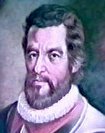
Magellan
returned to Portugal in 1512. On the 14th of July of
that year he was raised to the rank of fidalgo
escudeiro; and in 1513 he accompanied a Portuguese
expedition against Azamor in Morocco. The city was taken
on the 28th-29th of August 1513; but Magellan was
subsequently wounded, and lamed for life, in a sortie;
he was also accused of trading with the Moors. The
accusation was subsequently dropped, but Magellan fell
into disfavor with King Manuel, who let him understand
that he would have no further employment in his
country's service (after the 15th of May 1514). Magellan
formally renounced his nationality, and went to offer
his services to the court of Spain. He reached Seville
on the 20th of October 1517, and thence went to
Valladolid to see Charles V. With the help of Juan de
Aranda, one of the three chief officials of the India
House at Seville, and of other friends, especially Diogo
Barbosa, a Portuguese like himself, naturalized as a
Spaniard, who had acquired great influence in Seville,
and whose daughter he now married, he gained the ear of
Charles and of the powerful minister, Juan Rodriguez de
Fonseca, bishop of Burgos, the persistent enemy of Christopher
Columbus, the steady supporter of his great
successor.
Magellan
proposed to reach the Spice Islands of the East Indies
by the west; for that purpose he hoped to discover a
strait at the extreme south of South America, and is
said to have declared himself ready to sail southwards
to 75 degrees to realize his project. Ruy Faleiro the
astronomer, another Portuguese exile, aided him in the
working out of his plan, and he found an invaluable
financial ally in Christopher de Haro, a member of a
great Antwerp firm, who owed a grudge to the King of
Portugal. On the 22nd of March 1518, Magellan and
Faleiro, as joint captains-general, signed an agreement
with Charles V, by which one-twentieth of the clear
profits were to fall to them; further, the government of
any lands discovered was vested in them and their heirs,
with the title of Adelantados. On the 10th of
August 1519, the fleet of five vessels, under Magellan's
command, left Seville and dropped down the Guadalquivir
to S. Lucar de Barrameda, at the mouth of the river,
where they remained more than five weeks.
On
the 20th of September the armada put to sea. Of the
vessels which composed it, the "Trinidad" was
the flagship, and the "Vittoria" the only one
which accomplished the circumnavigation. The crew,
officers, volunteers, etc., numbered about 270-280, of
whom the names of 268 are preserved; 237 of these
received pay; at least 37 were Portuguese, 30 or more
Italians (mostly Genoese), 19 French, 1 English, 1
German. Only 31 returned in the "Vittoria"; 4
survivors of the crew of the "Trinidad"
reappeared later. Antonio Pigafetta of Vicenza, an
Italian gentleman who has left the best history of the
voyage, went as a volunteer in Magellan's suite. Faleiro
stayed behind, having cast his horoscope and found that
the venture would be fatal to him. The fleet was well
armed, and the total cost of equipment was 8,751,000
maravedis, or £5032. Three-quarters were defrayed by
the Spanish Crown, one-quarter by Christopher Haro and
his friends. Before starting, Magellan made his will and
addressed a memorandum to Charles V, assigning
geographical positions connected with the controversy he
was intending to settle: viz., the proper drawing of a
demarcation-line between the spheres of Spain and
Portugal in the East Indies, and the inclusion of the
Moluccas within the Spanish sphere.
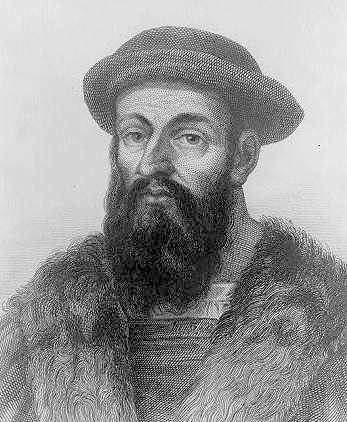
Steering
southwest and calling at Teneriffe (September 26 to
October 3), Magellan sighted South America at Cape St.
Augustine, near Pernambuco on the 29th of November;
thence he followed the east coast of the New World down
to the La Plata estuary, which he examined in the hope
of finding a passage at this point (January 11 to
February 6, 1520). On the 31st of March following, he
arrived at Port St. Julian where he wintered. Here he
crushed a formidable mutiny (April 1-2), and made
acquaintance with the natives, whom he called Patagonians
("Big Feet"), whose great size and lofty
stature are magnified by Pigafetta to gigantic
proportions. Leaving Port St. Julian on the 24th of
August 1520, he discovered on the 21st of October the
cape of the Eleven Thousand Virgins, the eastern
entrance of the long-sought passage. Through this
strait, 360 miles long, often narrow and very tortuous,
fringed by snow-clad mountains, he guided his armada for
thirty-eight days, weakened by the desertion of one
vessel, the "S. Antonio.".
On
the 21st of November a council of pilots and captains
was held to consider the continuation of the voyage, and
on the 28th of November the fleet rounded Cabo Deseado,
the "desired" western terminus of the strait,
variously called by the first discoverers,
"Victoria Strait", "Strait of the
Patagonians", "of all Saints", "of
the Eleven Thousand Virgins", or "of
Magellan", now only known by the last of these
names. To the south of the passage lay the forbidding
land "stark with eternal cold", which from the
many fires here observed Magellan named "Tierra del
Fuego." The expedition now entered the "Great
South Sea", first sighted by Vasco Nuñez de Balboa,
which, from the steady and gentle winds that drove the
fleet across the immeasurable expanse, was by Magellan
called "Pacific." For ninety-eight days
Magellan crossed this sea, almost beyond the grasp of
man's mind for vastness (as Maximilian of Transylvania
puts it), from Cabo Deseado to the Ladrones. On the
whole transit he discovered only two islands, sterile
and uninhabited, which he called "St Paul's"
(January 24, 1521) and "Shark Island"
(February 3). The first of these has been identified
with Puka Puka in the Tuamotu Archipelago, the second
with Flint Island in the Manihiki group; neither
identification seems convincing. For most of these
ninety-eight days the explorers had no fresh provisions,
little water (and that bad), and putrid biscuit; the
ravages of scurvy became terrible.
The
worst anticipations of Magellan ("he would push on,
if they had to eat the leather of the rigging")
were realized; ox-hides, sawdust, and rats became
coveted food. At last, on the 6th of March 1521, the
Ladrones (so named by Magellan from the thievish habits
of the natives) came in sight, Guam being probably the
first port of call. Here the fleet rested, watered,
revictualled and refitted; on the 9th of March they
started again westward; and on the 16th of March sighted
the southern point of Samar Island in the archipelago,
since 1542 called the Philippines, but named by
Magellan, its first discoverer, after St. Lazarus. On
the 7th of April the squadron arrived at Cebu, southwest
of Samar, in the heart of the Philippines; here Magellan
contracted a close friendship and alliance with the
treacherous native sovereign, who professed Christianity
the better to please and utilize his Catholic
friends.
Ever
the nobleman, he got himself involved in a political
alliance with the ruler of Cebu island, and joining his
Spanish forces with his ally's he launched an attack on
the Mactan islanders and was killed in the
process. Undertaking
an expedition to conquer, for the Catholic faith and the
king of Cebu, the neighbouring island of Mactan,
Magellan was killed there in a fight with the islanders
(April 27, 1521). The
king of Cebu after this got into his power several of
the leading personages of the squadron, including Juan
Serrano, one of the two admirals elected to replace
Magellan, and murdered them. The survivors, burning one
of the three remaining vessels, left the Philippines,
and made their way to the Moluccas (November 6),
visiting Borneo on the way (July 9 to September 27,
1521).
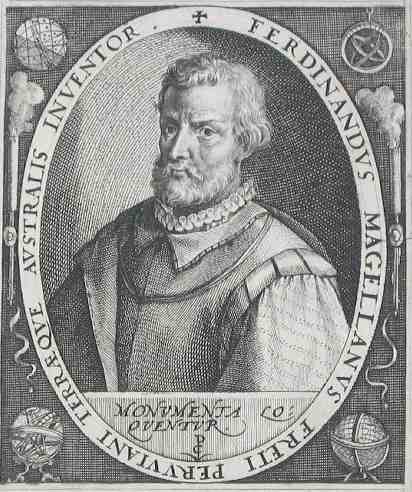
At
Tidor a heavy cargo of cloves was taken in the
"Trinidad", becoming leaky, stayed behind with
her crew; and the "Vittoria", under Juan
Sebastian del Cano, proceeded to Europe alone (December
21, 1521). To double the Cape of Good Hope the "Vittoria"
reached between 40 and 41 degrees S. (April 7-16, 1522)
and suffered from contrary winds, heavy seas, scurvy and
starvation. In the Cape Verde Islands (July 9-15, 1522)
thirteen of the crew were detained prisoners by the
Portuguese. Only thirty-one men returned with del Cano
to Seville in the first vessel that had ever made the
tour of the earth.
Though
Magellan had not quite reached the Spice Islands when he
fell at Mactan, his task had then been accomplished. He
had already reached and passed the longitude of the
Moluccas, where he had already been; the way home from
the Philippines by the Indian Ocean and the Cape of Good
Hope was perfectly known to the Portuguese, himself
included. Magellan's name has never received its due
recognition in general history. It ranks with those of
Columbus, Marco Polo, and Henry
the Navigator. The circumnavigation of the globe is
as great an event as the discovery of America. Magellan
achieved what Columbus planned - the linking of west
Europe with east Asia by direct transit over the western
ocean. Had America not intervened, the project of 1492
must have failed; by 1519 European pioneers had formed a
more adequate notion of the task and its magnitude.
Magellan's
Straits, the Magellanic clouds (not first observed by
him), and Magellan's Land - a name long given to
Patagonia and that hypothetical southern continent of
which Tierra del Fuego was considered only a portion,
and now again bestowed by Chile on her territory in the
extreme south -- preserve the memory of the first
circumnavigator. The largest of the oceans has also kept
the flattering name given to it by the man who first
crossed it.
No
record of his exploits was left by Magellan himself; and
contemporary accounts are less detailed and consistent
than could be wished.
The
best is that of Antonio Pigafetta, a volunteer in the
fleet. It is printed in Ramusio, and exists in four
early manuscript copies, one in Italian and three in
French. The latter was perhaps the original language of
this work, which was addressed by Pigafetta, as a knight
of Rhodes, to the Frenchman Villiers de l'Isle Adam,
grand master of the order of the Hospital of St. John.
But this view is rejected by J. A. Robertson, who
believes the Ambrosian manuscript to be the ultimate
text. See the Primo viaggio intorno al mondo,
otherwise the Navigation et descouvrement de la India
supérieure faicte par moi Anthoyne Pigapheta, Vincentin,
chevallier de Rhodes, probably published in 1524 (in
August of that year Pigafetta obtained leave to print
his book in Venice). Of the three French manuscripts two
are in the Bibliotheque Nationale, Paris (5650 and
24,224 Fr.), the latter is wrongly supposed by Thomassy,
followed by Lord Stanley of Alderley, to have been the
copy presented by Pigafetta to the regent of France,
Marie Louise of Savoy, mother of Francis I.
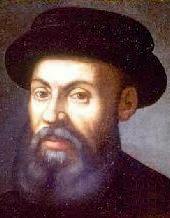
The
third French manuscript, often called the Manuscript of
Nancy, first noticed by Thomassy in 1841, was bought by
Sir Thomas Phillipps at Libri's sale, and became
Manuscript Phillipps 16,405. The Italian manuscript is
in the Ambrosian library at Milan. From this Carlo
Anoretti, prefect of the Ambrosiana, published his
Italian edition of Pigafetta in 1800; a French
translation of this, by Amoretti himself, was issued by
H. J. Jansen, 1801. An English version of Pigafetta was
made by Richard Eden in his Decades of the Newe
Worlde (London, 1555). The earliest printed edition,
apparently a summary of the Italian manuscript, was
issued in French by Simon de Colines of Paris about
1525. The earliest Italian edition is of 1534 (or 1536).
Other
authorities are: (1) The narrative of an unknown
Portuguese in Ramusio's Navigationi et viaggi;
(2) the Derrotero or Log-Book in the Seville
Archives, supposed to be the work of Francisco Albo, contramaestre
of Magellan's flagship, the "Trinidad"; this
consists mainly of nautical observations; (3) the
narrative of the so-called Genoese pilot, written in
excellent Portuguese, and printed in vol. iv. of the Collecão
de noticias of the Lisbon Academy; (4) various informaciones
and other papers in the Seville Archives, especially
bearing on the mutiny; (5) the letter of Maximilian of
Transylvania, under-secretary to Charles V, to the
cardinal of Salzburg; (6) the references in Correa and
Herrera, often based on good information, and adding
points of interest to other records. Of these 1-3, 5,
and an instance of 6 are translated in the Hakluyt
Society's volume. Magellan's two wills (i) executed at
Belem on the 17th of December 1504, on the eve of his
departure with Almeida, (ii) executed at Seville on the
24th of August, 1519, just before starting on his voyage
round the world, are both of some value for his life.
|
Name
|
Rating
|
|
Juan
Sebastian Elcano, from Getaria
|
Master
|
|
Francisco
Albo, from Axio
|
Pilot
|
|
Miguel
de Rodas
|
Pilot
|
|
Juan
de Acurio, from Bermeo
|
Pilot
|
|
Antonio
Lombardo (Pigafetta), from Vicenza
|
Supernumerary
|
|
Martín
de Judicibus, from Genoa
|
Chief
Steward
|
|
Hernándo
de Bustamante, from Alcántara
|
Mariner
|
|
Nicholas
the Greek, from Naples
|
Mariner
|
|
Miguel
Sánchez, from Rhodes
|
Mariner
|
|
Antonio
Hernández Colmenero, from Huelva
|
Mariner
|
|
Francisco
Rodrigues, Portuguese from Seville
|
Mariner
|
|
Juan
Rodríguez, from Huelva
|
Mariner
|
|
Diego
Carmena
|
Mariner
|
|
Hans
of Aachen
|
Gunner
|
|
Juan
de Arratia, from Bilbao
|
Able
Seaman
|
|
Vasco
Gomez Gallego the Portuguese, from Bayona
|
Able
Seaman
|
|
Juan
de Santandrés, from Cueto
|
Apprentice
Seaman
|
|
Juan
de Zubileta, from Barakaldo
|
Page
|
18
men returned to Seville with Victoria in 1522
Of
all the men who sailed with Magellan, only 18
returned to Spain in 1522. People were amazed when they
saw those on board the one remaining ship, Victoria, for
they looked starved and filthy. Odly enough, the
western sea route to the Spice Islands was not used for
many years. Spain was too busy taking land in South
America, and it was easier for the Portuguese to get to
the East by sailing eastwards around the Cape of Good Hope
at the southern tip of Africa.
His
fleet, or what was left of it, arrived at the Moluccas on
November 6, 1521. The sole ship to survive the
entire voyage, the Victoria, commanded by Juan
Sebastián del Cano, finally arrived at Seville on
September 6, 1522.
Ferdinand
Magellan (Sabrosa (Portugal), printemps 1480 - île
Mactan (Philippines), 27 avril 1521) était un navigateur
et explorateur portugais.
Au
XVe siècle, le fait que la terre était ronde n'était
certainement pas de notoriété publique. Bien que
Christophe Colomb avant Magellan ait pu l'affirmer ou du
moins s'approcher de cette vérité, le doute existait
toujours. À cette époque également, l'Europe avait développé
un goût pour les épices, peu communes dans la région.
Ce qui a développé l'intérêt de certains géographes,
explorateurs et commerçants. L'un de ceux-ci, Magellan,
croyait fortement qu'il pouvait trouver d'autres terres
vers l'ouest, et même sur des terres que l'Espagne
pouvait considérer siennes d'après le traité de
Tordesillas.
Il
proposa donc premièrement ces services au roi de
Portugal. Il faut se rappeler qu'en ces temps éloignés,
des commandites était nécessaires pour envisager des expéditions
d'aussi grande durée.
Le
roi de Portugal n'a pas semblé être très impressionné
par les arguments de Magellan. Magellan fit donc la même
proposition au roi d'Espagne, Charles Quint (Charles Ier
d'Espagne), qui à ce moment n'était qu'un adolescent (il
n'avait que 18 ans), avec toutefois beaucoup de
responsabilités ; ce dernier fut convaincu par les
arguments de Magellan.
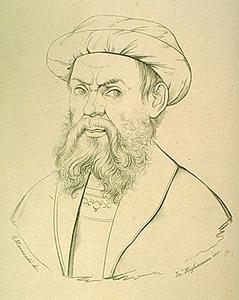
Father:
Rui de Magalhães
Mother: Alda de Mesquita
Brother: Diogo de Sousa
Sister: Isabel
Wife: Beatriz Barbosa (m. 1517, 1 son)
Son: Rodrigo
FRANCIS
DRAKE
Tales about the terrible conditions endured by Magellan's
men ensured that for more than 50 years no other
sailors attempted a circumnavigation. However, in 1577 Francis
Drake left England to rob Spanish treasure ships on
their way home from South America. He was also hoping to
find a northern short cut to the East.
After
stealing much gold and silver, he decided not to return
the way he had come in case Spanish ships were waiting to
attack him. Instead, he decided to set sail across the
Pacific to the Spice Islands then back to England by
rounding Africa. When he reached London in 1580, he was
knighted by Queen Elizabeth I for his exploit. He had
brought back spices and treasure worth a fortune in the
money of the time.
LINKS:
This
page contains links to educational sites around the
world under the headings provided. Content on
those sites may be the subject of author copyright,
which is hereby acknowledged.
|